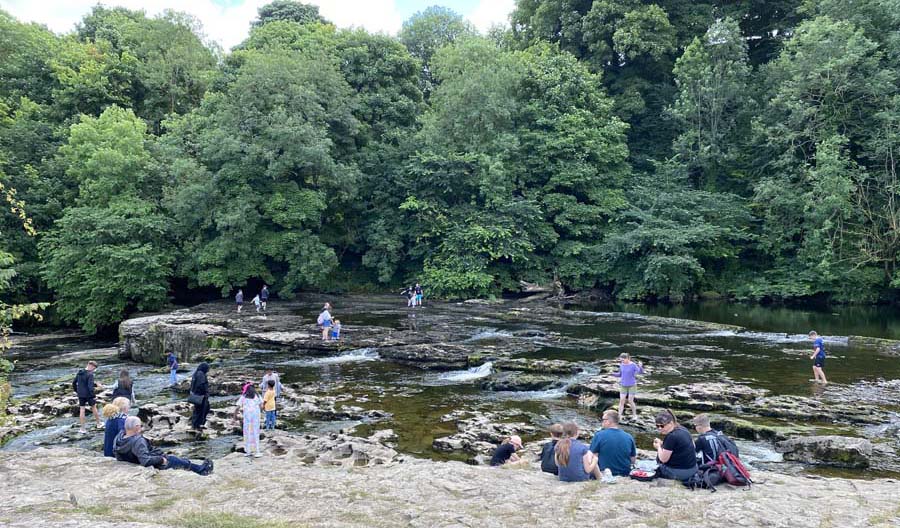
Stop Ure Pollution has issued a red alert for dangerous levels of E.coli and endotoxins in the River Ure in mid Wensleydale. This article is being updated when we hear of more people becoming ill due to contact with the water of the River Ure.
Photo by Pip Pointon: people bathing at Aysgarth Falls
In the past two weeks Stop Ure Pollution has been informed that eight people have fallen ill after contact with water in the River Ure and two were taken to hospital. Four of the incidents occurred at Aysgarth Falls.
That is not surprising given the results that the group’s chairman, Prof Richard Loukota has had using the nationally-recognised hand-held testing kit called Bactiquick on which there is a red light and a numerical value if there are high levels of endotoxins and, therefore, E.coli. Every time it has done just that and so shown that humans and dogs cannot enjoy the River Ure safely.
The tests at Aysgarth Falls, which is a very popular tourist attraction, were carried out on July 20 and 27 and on August 2. He has had similar results when carrying out weekly tests at Ulshaw Bridge.
Bactiquick detects a wide range of bacterial endotoxins including E.coli, Salmonella, Legionella and Vibrio and gives results in 15 minutes. Prof Loukota has then sent water samples to a registered lab and to Save Our Swale in Richmond for further E.coli testing.
He reported that the results of 10 consecutive E.coli cultures give 90th Centile reading of 2169 E.coli Colony Forming Units (CFU). As a guide: Excellent = 95th centile <500 CFU, Good =95th centile of <1000, Sufficient = 90th centile <900, Poor = numbers worse than these i.e. higher numbers of CFUs.
Bactiquick results are ‘high risk’ at levels above 58 ERU (endotoxin risk units), and the results from the Ure have been between 146 and 166.
Prof Loukota said: ‘This situation is very concerning and all water users should be aware of the risks, take the appropriate hand hygiene steps and should avoid ingesting river water particularly after rainy weather, when Combined Sewage Outlets are most likely to discharge and animal faecal matter is more likely to be washed into the river.’
Surfers Against Sewage, which funded the Bactiquick monitor, commented: ‘Stop Ure Pollution's dedicated citizen science shows their swim spot on the River Ure would be rated “Poor” by the regulator. And with swimmers falling ill from the river, it’s clear the monitoring system is failing water users – dangerously so. Under current regulations, only a handful of our rivers, lakes, and other inland waters have consistent, official testing for the impact of water quality on human health. Any dipper, paddler or swimmer diving in should be able to easily assess the risk, without community groups having to fill the data gap. No one should be left guessing whether their favourite swim spot will make them sick.’
Prof Loukota has carried out ten tests at Ulshaw Bridge as part of the Protecting Wild Waters project in conjunction with Surfers Against Sewage.
